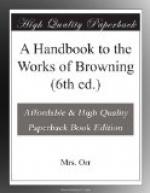The birth of his Sordello, as probably of the real one, coincides with the close of the twelfth century; and with an active condition of the family feuds which were just merging in the conflict of Guelphs and Ghibellines. The “Biographie Universelle” says:
“The first encounter between the two parties took place at Vicenza towards 1194. Eccelino the Second, who allied himself with the republics of Verona and Padua, was exiled from Vicenza himself his whole family and his faction, by a Podesta, his enemy. Before submitting to this sentence, he undertook to defend himself by setting fire to the neighbouring houses; a great part of the town was burned during the conflict, in which Eccelino was beaten. These were the first scenes of confusion and massacre, which met the eyes of the son of the Lord of Romano, the ferocious Eccelino the Third, born 4th of April, 1194.”
In Mr. Browning’s version, Adelaide, wife of Eccelino II., is saved with her infant son—this Eccelino the Third—by the devotion of an archer, Elcorte, who perishes in the act. Retrude, wife of Salinguerra, and also present on this occasion, only lives to be conveyed to Adelaide’s castle at Goito; but her new-born child survives; and Adelaide, dreading his future rivalry with her own, allows his father to think him dead, and brings him up, under the name of Sordello, as her page, declaring him to be Elcorte’s son adopted out of gratitude. The “intrigue” between him and Palma (Cunizza) appears in due time as a poetical affinity, strongest on her side, and which determines her to see him restored to his rightful place. Palma’s subsequent marriage with Richard, Count of San Bonifacio, serves to justify the idea of an engagement to him, ratified by her father before his retirement from the world, and which she and Salinguerra conspire to break, the one from love of Sordello, the other in the interests of her House. Eccelino’s real assumption of the monastic habit after Adelaide’s death is represented as in part caused by remorse—for Salinguerra is his old and faithful ally, and he has connived at the wrong done to him in the concealment of his son; and his return to the Guelph connexion from which his daughter has sprung, as a general disclaimer of his second wife’s views.
The Lombard League also figures in the story, as the consequence of Salinguerra’s and Palma’s conspiracy against San Bonifacio; though it also appears as brought about by the historic course of events. Salinguerra, under cover of military reprisals, has entrapped the Count into Ferrara, and detained him there, at the moment when he was expected to meet his lady-love in his own city of Verona. Verona prepares to resent this outrage on its Prince, and with it, the other States which represent the Guelph cause; and when Palma—seizing her opportunity—summons Sordello thither in his character of her minstrel, and reveals to him her projects for him and for herself, their interview is woven into the historical picture of a great mediaeval city suddenly called to arms. What Sordello sees when he goes with Palma to Ferrara, belongs to the history of all mediaeval warfare; and his sudden and premature death revives the historical tradition though in a new form. The intermediate details of his minstrel’s career are of course imaginary; but his struggle to increase the expressiveness of his mother tongue again records a fact.




